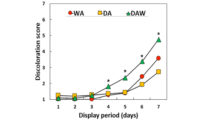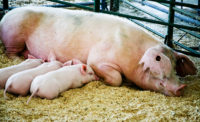Postmortem aging is well known to improve eating quality characteristics, such as tenderness, juiciness and flavor; however, extended aging periods have been demonstrated to lower oxidative stability of beef muscles, resulting in discoloration and possible rancidity. This is problematic, as consumers consider surface color of fresh meat products as an indicator of wholesomeness and freshness when making their purchasing decisions. In general, consumers begin to reject beef products when surface metmyoglobin (the oxidized form of myoglobin responsible for brown discoloration) levels reach a threshold of 20 percent. Therefore, developing mitigating systems to minimize rapid discoloration during display is crucial to reduce food waste and economic losses.
One of the well-known on-farm strategies to improve oxidative stability of fresh meat is to feed the animals with antioxidative feedstuffs, such as vitamin E. Recently, researchers from Purdue University evaluated the efficacy of supplementing ruminal bypass arginine (ARG) and lysine (LYS) to improve performance of beef steers, as well as oxidative stability of aged beef loins. ARG has been shown to have a multitude of roles in the body, such as enhancing immune function, regulating protein synthesis and mitigating the stress response. In pork, ARG supplementation was shown to improve intramuscular fat content and lower drip loss, the latter being attributed to improved antioxidative status of the muscle tissue. But no previous studies have evaluated the effects of ruminal bypass ARG supplementation on meat quality attributes and oxidative stability of aged beef loins. Dr. Brad Kim’s Meat Science and Muscle Biology group at Purdue University hypothesized supplementation of ARG may mitigate negative effects of extended aging storage on oxidative stability.
To determine this, 40 beef steers were split among four dietary treatments: control diet (no supplemental ARG or LYS), ARG (10 g/day metabolizable ARG), LYS (10 g/day metabolizable LYS) and ARGLYS (10 g/day both metabolizable ARG and LYS). Steers were fed this diet for 180 days, after which they were slaughtered at a commercial abattoir at a constant slaughter weight. At one day postmortem, paired loin sections were dissected from both sides of each carcass and assigned to aging times of either 14 or 28 days. Meat quality measurements included pH, Warner-Bratzler shear force, water-holding capacity and proximate analysis. Measures of oxidative stability included color stability over seven days simulated retail display evaluated both instrumentally and by trained panel, lipid oxidation by 2-thiobarturic acid reactive substances (TBARS) values and total reducing activity (TRA).
In terms of aging effect, results were as expected, as 28-day aging resulted in improved water-holding capacity and decreased shear force values (P < 0.05), indicating extended aging can improve qualities related to eating satisfaction. Adverse impacts of extended aging on oxidative stability were found, however, as the steak samples from aged loin sections had higher TBARS values, lower TRA and more rapid onset of discoloration during display (P < 0.05). Steaks from cattle that received supplemental ARG (ARG and ARGLYS) had improved color stability regardless of aging duration (P < 0.05). Moreover, a decrease in TBARS values and increase in TRA was observed in the ARGLYS treatment compared with ARG and LYS only treatments (P < 0.05), indicating there may be a synergistic effect of supplementing both amino acids.
The aforementioned improvements to oxidative stability resulting from ARG supplementation may be related to the production of nitric oxide (NO) via the L-arginine-nitric oxide pathway. There is increasing evidence that nitric oxide can scavenge hydroxy/peroxyl radicals, inhibit lipid oxidation and affect muscle redox state. Western blots, a means of detecting and analyzing proteins, for neuronal nitric oxide synthase (nNOS; the primary isoform in skeletal muscle tissue) are being conducted, as well as we are determining whether the dietary treatments may have influenced fatty acid composition.
In conclusion, these findings support that supplementation of ruminal bypass ARG could be an effective strategy to improve oxidative stability of beef loins with extended aging storage. Further studies to elucidate the mechanism through which ARG mitigates the negative effects of extended aging storage on color and oxidative stabilities are highly warranted.
Jacob Tuell, Hyun-Wook Kim, Juliana Guedes, Jin-Kyu Seo, Jon Schoonmaker and Yuan H. Brad Kim are part of the Meat Science and Muscle Biology Lab, Department of Animal Sciences, Purdue University. For more information, contact bradkim@purdue.edu.
- Barreiro, E., Gea, J., Corominas, J.M., and Hussain, S.N.A. (2003). Nitric Oxide Synthases and Protein Oxidation in the Quadriceps Femoris of Patients with Chronic Obstructive Pulmonary Disease. American Journal of Respiratory Cell and Molecular Biology. 29(6):771-778.
- Hood, D.E. and Riordan, E.B. (1973). Discolouration in pre-packaged beef: measurement by reflectance spectrophotometry and shopper discrimination. International Journal of Food Science and Technology. 8(3):333-343.
- Kaminski, H.J. and Andrade, F.H. (2001). Nitric oxide: biologic effects on muscle and role in muscle diseases. Neuromuscular Disorders. 11:517-524.
- Ma, D., Kim, Y.H.B., Cooper, B., Oh, J., Chun, H., Choe, J.H., Schoonmaker, J., Ajuwon, K., Min, B.R. (2017). Metabolomics profiling to determine effects of postmortem aging on color and lipid oxidative stabilities of different bovine muscles. Journal of Agricultural Food Chemistry. 65:6708-6716
- Ma, X., Lin, Y., Jiang, Z., Zheng, C., Zhou, G., Yu, D., Cao, T., Wang, J., and Chen, F. (2010). Dietary arginine supplementation enhances antioxidative capacity and improves meat quality of finishing pigs. Amino Acids. 38:95-102.
- Mancini, R.A. and Hunt, M.C. (2005). Current research in meat color. Meat Sci. 71(1):100-21. NRC. (2016). Nutrient Requirements of Beef Cattle. 8th rev. ed. Natl. Acad. Press. Washington, DC.
- Smith, R.D., Nicholson, K.L., Nicholson, J.D.W., Harris, K.B., Miller, R.K., Griffin, D.B., and Savell, J.W. (2008). Dry versus wet aging of beef: Retail cutting yields and consumer palatability evaluations of steaks from US Choice and US Select short loins. Meat Science. 79:631-639.
- Tan, B., Yin, Y., Liu, Z., Li, X., Xu, H., Kong, X., Huang, R., Tang, W., Shinzato, I., Smith, S.B., and Wu, G. (2008). Dietary L-arginine supplementation increases muscle gain and reduces body fat mass in growing-finishing pigs. Amino Acids. 37:169-175.
- Wink, D.A., Miranda, K.M., Espey, M.G., Pluta, R.M., Hewett, S.J., Colton, C., Vitek, M., Feelisch, M., and Grisham, M.B. (2001) Mechanisms of the Antioxidant Effects of Nitric Oxide. Antioxidants & Redox Signaling. 3(2):203-213.




Report Abusive Comment